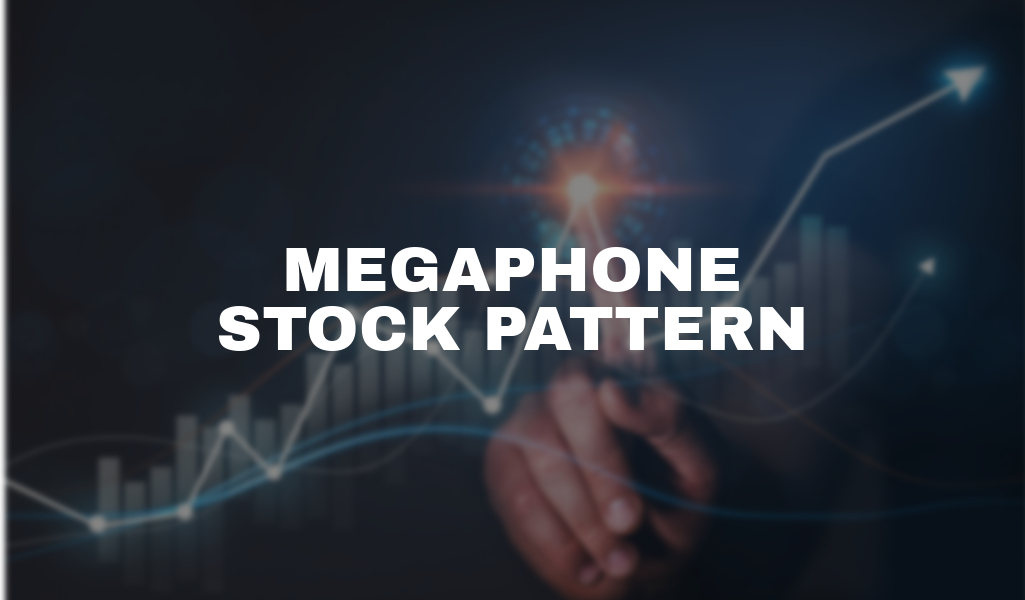Megaphone Stock Pattern: Amplifying Your Trading Strategies
The megaphone pattern is a notable chart formation often encountered in technical analysis, renowned for its association with high levels of market volatility. This volatility is precisely what makes it a favored pattern among traders, as it often translates into significant trading opportunities.
Characterized by its “broadening formation,” this pattern not only signals the potential for substantial price movements but also serves as a cautionary indicator of the heightened risks that may lie ahead.
The structure of the megaphone chart pattern is distinctive, offering traders diverse entry and exit strategies on its varying sides. This aspect of the pattern is particularly appealing, as it allows for a range of tactical approaches in navigating the financial markets.
A Megaphone Pattern is formed when numerous candlesticks collectively create a large, megaphone-like shape that slopes either up or down. This pattern can indicate a bullish or bearish trend based on its slope direction.
Important details
It’s important to note that the megaphone pattern is temporary and has the potential to break sharply either upwards or downwards. This breakout often occurs after the pattern’s upper or lower trendlines have been tested 5 to 8 times, indicating a significant shift in market sentiment and price movement.
The megaphone pattern emerges particularly in times of high market volatility. This pattern is characterized by its unique movement, where a stock exhibits significant fluctuation but does not follow a clear directional trend.
In contrast to typical stock behavior, where a trend is indicated by either consistently higher highs and lows (in a bullish trend) or lower highs and lows (in a bearish trend), the Megaphone Pattern displays both higher highs and lower lows simultaneously. This lack of a definitive trend within the pattern itself makes it stand out.
To accurately identify a Megaphone Pattern, it’s crucial to draw trend lines properly. This involves connecting the peaks and troughs on both sides of the chart to trace the pattern’s distinctive widening shape. This careful delineation is key to understanding the pattern’s potential impact on market price action.
Elections and megaphone stock pattern
Elections are a big factor in the formation of a megaphone stock pattern. The outcome of an election can steer the direction of a country, which invariably impacts financial markets. As markets grapple with unpredictability regarding political developments, this often results in oscillations between bullish and bearish sentiments, creating the ideal conditions for a megaphone pattern to develop.
Similarly, earnings seasons are pivotal in shaping the megaphone pattern. When companies announce their earnings, it can have a pronounced effect on their stock prices. Both positive and negative earnings reports can trigger varied reactions in the market.
Traders are acutely aware of the influence of market sentiment – optimism or pessimism – on stock movements. These diverse reactions contribute to the formation of patterns like the broadening formation, characterized by expanding price movements and heightened volatility.
The ability to profit from a megaphone pattern depends largely on your trading style and perspective. Interestingly, despite its appearance as a reverse symmetrical triangle, which is typically viewed as a neutral pattern, the Megaphone Pattern is often considered bearish, particularly for certain types of traders.
For long-term or trend traders, a broadening formation suggests bearishness due to its inherent volatility and lack of a clear directional trend. This kind of pattern can be challenging for those who prefer stable, directional trends. However, the scenario is quite different for day traders and swing traders, for whom volatility is not a drawback but an opportunity.
Day and swing trading
Day and swing trading strategies thrive on market volatility. These trading styles aim to capitalize on short-term price movements, making the Megaphone Pattern an attractive prospect. Unlike long-term investors who seek consistent trends, day and swing traders can leverage the fluctuating nature of this pattern to their advantage.
When trading a megaphone pattern, it’s common to focus on the pattern’s trend lines for buy or sell signals. Traders might consider going long when the price reaches the angular support and consider going short as it approaches angular resistance.
However, it’s crucial to stay alert for potential breakouts from the pattern, as the price can sometimes break sharply upward, moving beyond the established trend lines.
Technical analysis
In the realm of technical analysis, trend lines are crucial, particularly for those engaging in day and swing trading. The inherent volatility of a broadening formation, such as the Megaphone Pattern, offers these traders opportunities to capitalize on short-term market movements for profit.
Swing trading, which typically involves holding positions overnight and up to two weeks, heavily emphasizes risk management. Utilizing technical indicators is key in this strategy, as they facilitate quick entry and exit from trades.
Popular strategies
In stock trading, breakout trades and swing trades are two popular strategies, each with its own unique approach and objectives.
Breakout trading involves identifying and entering a stock when it moves outside a defined price range or technical pattern. The key concept here is that a breakout, whether above resistance or below support, signifies a potential significant move in the stock’s price.
Key aspects of breakout trades:
Identification of key levels: Traders look for significant levels of support and resistance. A breakout occurs when the stock price moves beyond these levels.
Volume confirmation: High trading volume during the breakout is often seen as a confirmation of the move, suggesting it’s more likely to sustain.
Momentum indicators: Tools like moving averages, RSI (Relative Strength Index), or MACD (Moving Average Convergence Divergence) can help in identifying potential breakouts.
Entry points: Traders enter the trade as soon as the price breaks through a key level, anticipating a strong move in the direction of the breakout.
Stop-loss orders: Given the risk of false breakouts, setting a stop-loss just below the breakout point for long positions (or above for short positions) is common.
Targets: Profit targets are often set based on historical price patterns or a predetermined risk-reward ratio.
Swing trades
Swing trading, on the other hand, is about capturing “swings” in market sentiment and price momentum over a short to medium term. It’s typically done over a few days to several weeks.
Characteristics of swing trades:
Timeframe: Positions are usually held for several days to a few weeks, capitalizing on a trend or a price pattern.
Technical analysis: Swing traders rely heavily on technical analysis to identify potential trading opportunities, looking for patterns like flags, pennants, or cup and handle formations.
Risk management: Essential in swing trading, involving setting stop-losses and having a clear exit strategy to protect profits and minimize losses.
Market trends: Swing traders often trade in the direction of the overall trend but look for retracements within that trend to enter.
Indicators and tools: Moving averages, Fibonacci retracement levels, RSI, and Stochastic Oscillators are commonly used to identify potential swings in the market.
Psychological factors: Swing traders need to be patient, waiting for the right opportunity, and disciplined, to follow through with their trading plan.
To sum up, it is vital to learn as much as possible about a megaphone stock pattern. Hopefully, learning the most important details regarding a megaphone stock pattern is quite easy.
The post Megaphone Stock Pattern: Amplifying Your Trading Strategies appeared first on FinanceBrokerage.























